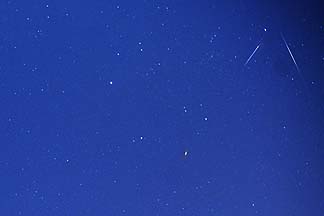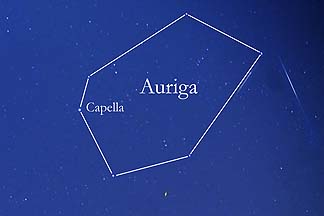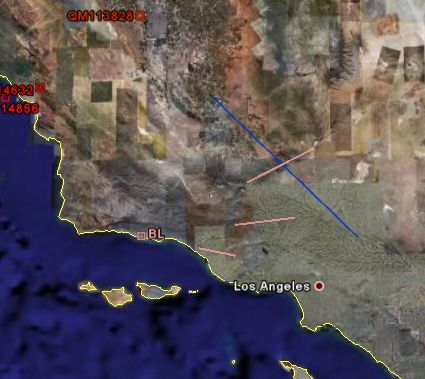
Perseid and Aurigid Meteor Showers
|
(Download a higher resolution picture by clicking on any picture below.)
 This composite image shows three meteors in the sky over Goleta on the morning of Saturday September 1. One of the meteors left a very short trail below and to the right of the center of the image. The meteor on the right may not be part of the Aurigid shower. I set up my camera to take a 30-second long exposure every thirty-one seconds. The lens was wide open at f3.5 and the ISO was set to 1600. These meteors were captured in exposures made at 4:13, 4:20, and 5:27 AM PDT.
This composite image shows three meteors in the sky over Goleta on the morning of Saturday September 1. One of the meteors left a very short trail below and to the right of the center of the image. The meteor on the right may not be part of the Aurigid shower. I set up my camera to take a 30-second long exposure every thirty-one seconds. The lens was wide open at f3.5 and the ISO was set to 1600. These meteors were captured in exposures made at 4:13, 4:20, and 5:27 AM PDT.
 This image shows the constellation of Auriga. Capella is the brightest star in Auriga.
This image shows the constellation of Auriga. Capella is the brightest star in Auriga.
 A team correlating Aurigid meteor observations from multiple observers to create 3-D trajectories produced these meteor tracks (pink lines) of the three meteors that I photographed. The very short meteor corresponded to one observed from Lick Observatory on Mount Hamilton. The Lick Observatory observation is the blue line.
A team correlating Aurigid meteor observations from multiple observers to create 3-D trajectories produced these meteor tracks (pink lines) of the three meteors that I photographed. The very short meteor corresponded to one observed from Lick Observatory on Mount Hamilton. The Lick Observatory observation is the blue line.
 This view shows the meteors from the perspective of Lick Observatory.
This view shows the meteors from the perspective of Lick Observatory.
 This composite image shows three Perseid meteors in the sky over Goleta on the morning of Monday, August 13. I set up my camera to take a 10-second long exposure every eleven seconds. That way the shutter was open more than 90% of the time. The lens was wide open at f3.5 and the ISO was set to 1600. The camera fired off 796 exposures between 1:27 and 3:55 AM. The meteor's tracks point back toward the shower's radiant in the constellation Perseus. These meteors were captured in exposures made at 1:31, 1:42, and 3:19 AM.
This composite image shows three Perseid meteors in the sky over Goleta on the morning of Monday, August 13. I set up my camera to take a 10-second long exposure every eleven seconds. That way the shutter was open more than 90% of the time. The lens was wide open at f3.5 and the ISO was set to 1600. The camera fired off 796 exposures between 1:27 and 3:55 AM. The meteor's tracks point back toward the shower's radiant in the constellation Perseus. These meteors were captured in exposures made at 1:31, 1:42, and 3:19 AM.
The starry sky revolves around the North Star over 2-1/2 hours in this time lapse video taken during the Perseid Meteor Shower. Several Asia bound airliners cross the sky and a couple of Perseid Meteors flash by. The Earth's rotation is speeded up by a factor of 275x.
Send a message to Brian.